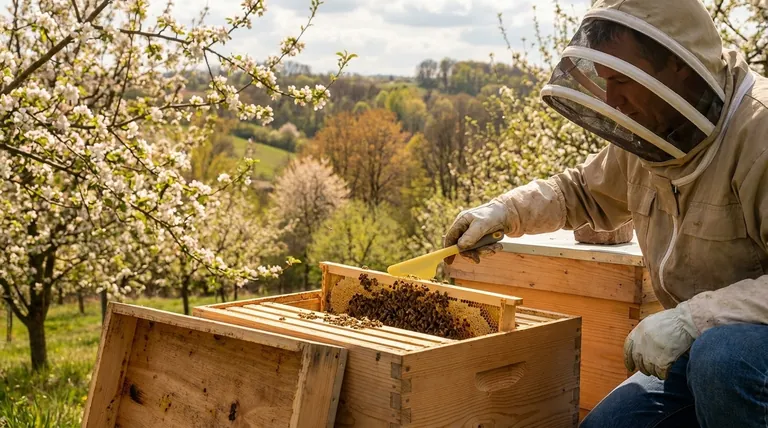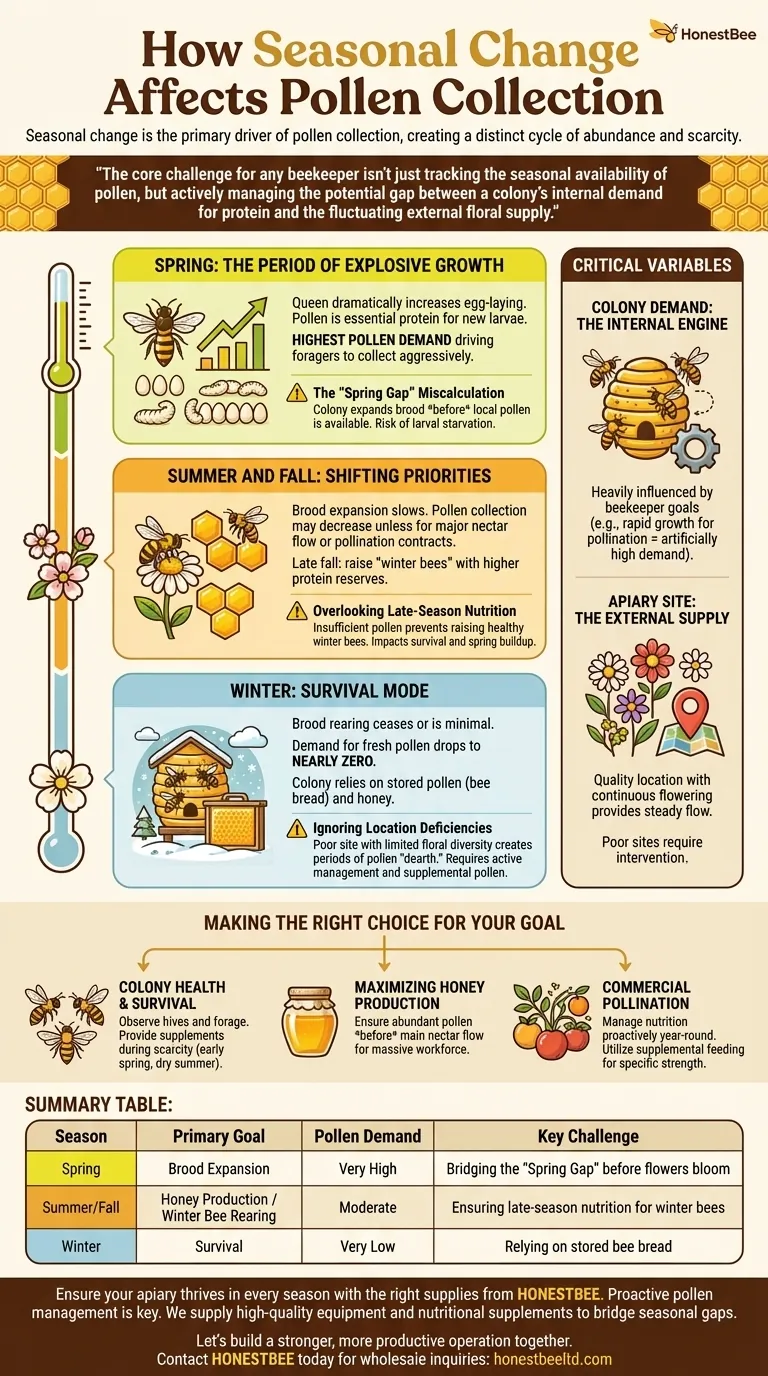Seasonal change is the primary driver of pollen collection, creating a distinct cycle of abundance and scarcity. A honey bee colony's demand for pollen peaks in early spring, as increasing daylight and flowering plants trigger a massive expansion of the brood nest. This demand is fundamentally tied to the colony's internal need for protein to raise new bees.
The core challenge for any beekeeper isn't just tracking the seasonal availability of pollen, but actively managing the potential gap between a colony's internal demand for protein and the fluctuating external floral supply.

The Seasonal Rhythm of Pollen Demand
A colony's need for pollen is not constant. It follows a predictable annual pattern directly linked to its reproductive and survival cycles.
Spring: The Period of Explosive Growth
In early spring, the queen dramatically increases her egg-laying rate. Pollen is the essential protein source used to feed this new generation of larvae.
This surge in brood rearing creates the highest pollen demand of the entire year, driving foragers to collect it aggressively from early-blooming flowers.
Summer and Fall: Shifting Priorities
As the season progresses, the rate of brood expansion typically slows. Pollen collection may decrease unless large bee populations are needed for a major nectar flow (to produce honey) or commercial pollination contracts.
In late fall, colonies collect pollen to raise "winter bees," which have higher protein reserves to survive the cold months.
Winter: Survival Mode
During winter, brood rearing ceases or is minimal in most climates. Consequently, the demand for fresh pollen drops to nearly zero.
The colony relies on stored pollen (bee bread) and honey to sustain itself until spring arrives once again.
Beyond Seasons: The Two Critical Variables
While seasons set the overarching rhythm, two other factors determine the success of pollen collection: the colony's specific needs and its physical location.
Colony Demand: The Internal Engine
A colony's demand for pollen is not purely natural; it's heavily influenced by the beekeeper's goals.
If the goal is rapid population growth for pollination work, the demand for pollen will be kept artificially high, even outside of the natural spring peak.
Apiary Site: The External Supply
The quality of the apiary site is paramount. A location with a diverse and continuous sequence of flowering plants can provide a steady pollen flow for much of the year.
Conversely, a poor site with limited floral diversity will create periods of pollen "dearth," forcing the beekeeper to intervene.
Understanding the Pitfalls
Managing pollen availability requires anticipating common problems that arise from the mismatch between colony needs and nature's supply.
The "Spring Gap" Miscalculation
A common issue is when a colony begins expanding its brood nest in response to warmer weather before local pollen sources are available.
This gap between demand and supply can lead to larval starvation and a significant setback for the colony's development.
Overlooking Late-Season Nutrition
Focusing only on the spring buildup is a mistake. Insufficient pollen in the late summer and fall can prevent the colony from raising healthy, robust winter bees.
This directly impacts the colony's ability to survive the winter and build up strongly the following spring.
Ignoring Location Deficiencies
A beekeeper who places a colony in a poor location without a plan for nutritional support is setting it up for failure.
Relying solely on the environment is only viable in premium locations. Most sites require active management and readiness to provide supplemental pollen if a shortage occurs.
Making the Right Choice for Your Goal
Your approach to pollen management should be dictated by your specific objectives for your bees.
- If your primary focus is colony health and survival: Observe your hives and local forage closely, and be prepared to provide pollen supplements during known periods of scarcity, like early spring or a dry summer.
- If your primary focus is maximizing honey production: You must ensure an abundant supply of pollen before the main nectar flow to build a massive workforce capable of gathering a surplus.
- If your primary focus is commercial pollination: You must manage nutrition proactively year-round, often relying on supplemental feeding to grow colonies to a specific strength, independent of the local season.
Ultimately, understanding and managing the balance between pollen demand and supply is the foundation of a healthy and productive colony.
Summary Table:
| Season | Primary Goal | Pollen Demand | Key Challenge |
|---|---|---|---|
| Spring | Brood Expansion | Very High | Bridging the 'Spring Gap' before flowers bloom |
| Summer/Fall | Honey Production / Winter Bee Rearing | Moderate | Ensuring late-season nutrition for winter bees |
| Winter | Survival | Very Low | Relying on stored bee bread |
Ensure your apiary thrives in every season with the right supplies from HONESTBEE.
Whether you manage a few hives or are a distributor supplying commercial apiaries, proactive pollen management is key to colony health, honey production, and pollination success. HONESTBEE supplies the high-quality beekeeping equipment and nutritional supplements you need to bridge seasonal gaps and meet your specific goals.
Let's build a stronger, more productive operation together.
Contact HONESTBEE today for wholesale inquiries to discuss your needs.
Visual Guide

Related Products
- Professional Long-Handled Silicone Honey Scraper for Beekeeping
- Professional Wide Blade Honey Scraper for Beekeeping and Honey Processing
- Stainless Steel Scraper for Metal Queen Bee Excluders
- Professional Galvanized Hive Strap with Secure Locking Buckle for Beekeeping
- Versatile Ratchet Hive Strap with S-Hooks for Secure Fastening
People Also Ask
- How much time does it take to do beekeeping? A Realistic Breakdown for Beginners & Pros
- What are the basic components of beekeeping equipment? Build a Thriving Hive from the Start
- How can a capping scratcher be used with an electric knife? Boost Efficiency and Honey Yield
- What tools are available for uncapping honey? A Guide to Choosing the Right Tool for Your Operation
- What other tools are available for honey uncapping besides knives? Find the Right Tool for Your Apiary's Scale



















